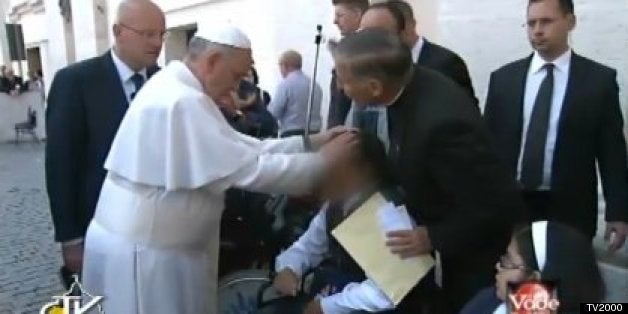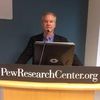
While Pope Francis did not perform a formal exorcism on the young man in wheel chair, he clearly realized an informal one known as a prayer of deliverance from evil. Without access to the transcript of his prayer, we are of course limited to the video footage of the event. However, we do know that the Mexican priest who brought the young man to Rome presented him to the pope as demon-possessed. Having observed hundreds of such exorcisms during the course of my research in Latin America, I view his firm and determined laying of both hands on the head of the afflicted young man as strong evidence of the pope having performed an informal exorcism in the form of a deliverance prayer. Note how, in contrast, he places only one hand on the head of the young woman he blesses, without a prayer of deliverance, right after exorcising the young man.
Since the late 1980s, competition with Pentecostalism has led to the formation of a cadre of Latin American priests affiliated with the Catholic Charismatic Renewal (CCR) who specialize in "liberation" or exorcism ministries. Such is current parishioner demand for release from demonic possession that some priests, such as Brazilian Charismatic superstar Father Marcelo Rossi, even celebrate "liberation masses" (missas de libertação) on a weekly basis. Acknowledging his pastoral debt to Brazilian Pentecostal leader, Bishop Edir Macedo, whose Universal Church of the Kingdom of God brought exorcism to the fore of Spirit-centered Christianity in Latin America, Padre Marcelo stated in an interview that "it was Bishop Edir Macedo who woke us up. He got us up."
Behind closed doors, CCR lay leaders also practice unofficial exorcism on believers manifesting symptoms of satanic influence. Many bishops feel such unsanctioned exorcisms are a threat to their ecclesiastical authority and have issued statements denouncing the practice. In its official statement of approval of the CCR in 1986, the Guatemalan Episcopal Conference referred to "irregularities" with exorcisms and reminded Charismatics that the rite can only be performed by priests with proper episcopal consent. The same year, the bishop of the Mexican industrial city of Toluca also informed the CCR of the need for episcopal authorization of any exorcism taking place in his diocese. In one of the most extreme reactions to the practice of unauthorized exorcism, Archbishop Juan Sandoval of Guadalajara excommunicated several members of the Nueva Alianza (New Alliance) CCR covenant community for expelling demons without his approval and also on account of their "Protestant tendency," which led them, according to the bishop, to ignore the role of the Virgin.
As the CCR has expanded among the Latin American working classes, demand for physical healing and exorcism has become much greater than in the past. Many impoverished urban Catholics, like their Pentecostal counterparts, seek divine resolution of their poverty-related afflictions. Thus, grassroots Charismatics typically implore the Holy Spirit to empower them to overcome such afflictions as alcoholism, unemployment, physical illness, domestic strife and demonic oppression, the latter of which in Brazil and much of the Caribbean often takes the form of possession by the exús, or liminal trickster spirits of Candomble, Umbanda and other African diasporan religions. Like Pope Francis, Catholic Charismatics are very focused on the role of the Devil and see his hand is such "vices" as soap operas and drinking. Exorcism in the CCR, however, has not developed to the point that it has in the Universal Church of the Kingdom of God and other NeoPentecostal denominations where the demons (in the form of Umbanda or Candomble spirits) are actually invoked to then be expelled in dramatic fashion by combative pastors.
As shocking as it may be to some observers and Catholics in the Global North, Pope Francis' informal exorcism neatly captures the rise of the Global South, where prayers for deliverance from evil are common Catholic (and Pentecostal) currency. It would appear that the first pope from the Global South has not only opted for the poor but also has adopted a preferential option for the Spirit.
